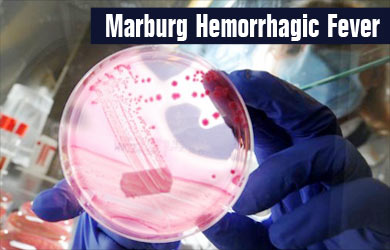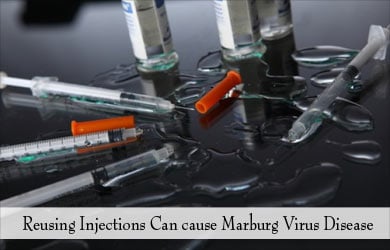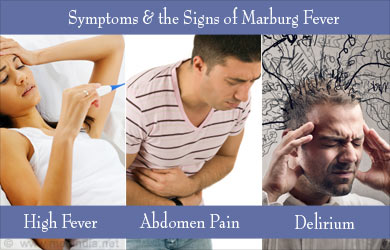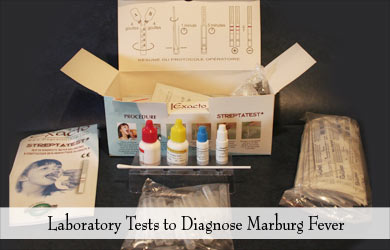- Marburg virus disease - (http://www.who.int/csr/disease/marburg/en/)
- Marburg hemorrhagic fever (Marburg HF) - (http://www.cdc.gov/vhf/marburg/)
- Ebola virus and Marburg virus - (http://www.mayoclinic.org/diseases-conditions/ebola-virus/basics/definition/con-20031241)
- Kajihara M, Nakayama E, Marzi A, Igarashi M, Feldmann H and Takada A; 'Novel mutations in Marburg virus glycoprotein associated with viral evasion from antibody mediated immune pressure.' The Journal of General Virology, July 2013
- Thi EP, Mire CE, Ursic Bedoya, Geisbert JB, Lee AC, Agans KN, Robbins M, Deer DJ, Fenton KA, MacLachlan, Geisbert TW 'Marburg virus infection in nonhuman primates: Therapeutic treatment by lipid-encapsulated siRNA.' Science translational medicine, 2014 August
What is Marburg Hemorrhagic Fever?
Marburg hemorrhagic fever first became significant during an outbreak in Marburg and Frankfurt - Germany when infected monkeys brought for research purposes from Uganda caused an accidental spread among humans.
What is the Cause of the Marburg Hemorrhagic Fever?
Marburg fever is caused by the Marburg viruses - Marburg virus (MARV) and the Ravn (RAVV) virus, which are animal viruses wherein the initial infection arises from an animal to human contact, after which it spreads through person-to-person contact. The Marburg virus is highly virulent, capable of setting off an outbreak with many fatalities.

Marburg and Ebola virus diseases are clinically similar and viruses that cause them belong to Filoviridae family (filovirus).
The virus is native to the African fruit bat Rousettus Aegyptiacus and the bat does not show any symptoms of the disease. Primates (monkeys and humans) when infected with the virus display severe symptoms.
From time to time sporadic cases of Marburg fever are seen in Uganda, mostly when workers from the ‘Mining Industry’ come in contact with infected bats. Poor hygiene and personal care result in spread of the fever among the community.
Spread of the Virus from animals-to-humans occurs through:
- Contact with body fluids: Contact with blood while killing the animals or while cooking or eating the infected animals will result in spread of the virus. Scientists who studied infected monkeys have also been found to contract the disease.
- Contact with bat guano: Mine workers and tourists who come in contact with wastes from bat like urine and faeces also get infected.
Spread from person-to-person:
Although this virus originates from animals, person-to-person spread is very rapid and occurs when there is contact with the infected individual. An infected person does not become infectious nor will not spread the infection till the individual begins to display symptoms of the disease:
- Caregiver- Relatives or friends who look after the infected person are often infected as they fail to protect themselves appropriately
- Doctors and other hospital staff- Doctors and hospital staff who treat patients may be associated with an accidental cut leading to spread of the disease
- Re-using injections and syringes- Reusing injections or using the same syringe for multiple patients will result in the spread of the disease. Cash torn hospitals in Africa witness extensive spread of the disease due to reusing of the syringes.

- Researchers- Research scientists who handle primates for their experiments are also at increased risk of infection.
- Preparing the dead for burial- The disease spreads when people prepare the body for burial without protective gear.
What are the Symptoms and the Signs of Marburg Fever?
The incubation period of Marburg fever ( i.e. time interval from infection to onset of symptoms) varies from 2 to 21 days. Symptoms include the following:
- Maculopapular rashes that develop in the head, neck and stomach
- High fever
- Severe headache
- Chills
- Nausea
- Vomiting
- Abdomen pain
- Cramping
- Muscle pain
- Sore throat
- Chest pain
- Fatigue
- Watery diarrhea
- Joint pain
- Excessive weight loss
- Delirium
- Jaundice

Severe haemorrhagic manifestations result in some form of bleeding from multiple areas like the nose, ear, gums and rectum. Death is largely due to severe hemorrhage.
The curious factor about this virus is though there is no ‘cure’ or vaccination for this disease, some people survive while others do not. The reason behind this remains unknown. People who do recover from the fever, do so after a long period of time, sometimes even take months to regain their strength, They may exhibit the following signs:
- Inflammation of the eye, liver or the testis, or all three
- Loss of hair
- Headaches
- Excessive weight loss
- Sensory changes
- Hepatitis
How to Diagnose Marburg Fever?
Initially Marburg fever resembles malaria or typhoid, which makes diagnosis difficult. This is especially true when the case is unique and not part of an outbreak. The risk is determined by whether
- The individual has travelled to Africa or Marburg fever prone areas in the recent past
- The individual was associated with a person/animal infected with the virus
Marburg hemorrhagic fever is detected by a number of different tests:
- Enzyme-Linked Immunosorbent Assay (ELISA)
- Reverse-Transcriptase Polymerase Chain Reaction (RT-PCR) Assay
- Isolating the virus by cell culture
- Antigen detection tests

How do you Treat Marburg Fever?
There is no specific anti-viral drug for the Marburg virus, nor is there any vaccination, though scientists are working almost overtime to find effective means of protection. Studies have shown that mutations in the glycoprotein of the virus are responsible for their successful evasion of the immune system. During infection, the host immune cells recognize certain regions of the virus which help them host an immune response. However, the Marburg virus has been found to have structural flexibility that prevents recognition by the host’s immune system, which results in the flourishing spread of the disease.
Treatment for Marburg fever, therefore, depends on the symptoms exhibited by the host.
- Blood pressure monitoring and maintenance
- Oxygen support
- Fluid administration
- Treatment of secondary infections
- Blood transfusions

Though there are no specific treatment methods for Marburg hemorrhagic virus in humans, there are several studies that are being carried out on primates like monkeys and apes. Notable of those is the use of Si RNA. Sixteen monkeys were infected with the virus and injected with the Si RNA at varying stage of the disease progression, from 30 minutes after injection of the virus to 3 days. All monkeys that were injected with the Si RNA survived while the controlled monkeys which did not receive the Si RNA injection died.
Other studies detail the identification of new antibodies that are found to be effective against Marburg virus.
Prevention of Marburg Fever
A disease of any kind is detrimental to health and more so with Marburg fever as there is no specific treatment while the virus is highly virulent. Therefore, it is better to be cautious to safeguard health.
- If there is an outbreak in a particular region, avoid travelling to the area
- Be careful while handling wild animal meat or hunting
- Be aware of its spread from bat guano in caves
- Use gloves and a mask while handling friends/ relatives with the disease.
- Be careful with needles used on a sick patient
- Avoid handling sick monkeys






